| Piaggio P.23M | |
|---|---|
 | |
| Role | Commercial transport aircraft prototype |
| National origin | Italy |
| Manufacturer | Piaggio |
| First flight | 1935 |
| Number built | 1 |
The Piaggio P.23M was an Italian commercial transport aircraft prototype designed and built by Piaggio.
| Piaggio P.23M | |
|---|---|
 | |
| Role | Commercial transport aircraft prototype |
| National origin | Italy |
| Manufacturer | Piaggio |
| First flight | 1935 |
| Number built | 1 |
The Piaggio P.23M was an Italian commercial transport aircraft prototype designed and built by Piaggio.
Piaggio designed the P.23M specifically for flights across the North Atlantic Ocean, intending it to have potential for development as a commercial transport. [1] It was a four-engine shoulder-wing monoplane with inverted gull wings and twin tail fins and rudders. [1] To allow an easier landing if the aircraft had to ditch at sea, its fuselage was designed like a boat hull, which Piaggio termed an avion marin ("marine aviation") design, although the aircraft was not a flying boat. The main landing gear was retractable. The P.23M's four 671 kW (900 hp) Isotta-Fraschini Asso XI R. V-12 engines were mounted on the wings in two tandem pairs, each engine driving a two-bladed propeller; two of the propellers were mounted as pushers and the other two in a tractor configuration.
Piaggio claimed a top speed of 400 kilometers per hour (249 miles per hour) for the P.23 and projected its maximum range at a cruising speed of 300 km/h (186 mph) as 5,100 kilometers (3,169 statute miles).
The P.23 first flew in 1935. No attempt to fly the Atlantic Ocean ever took place, and its predicted maximum range capabilities never were tested. The aircraft soon was disassembled and never flew again.
No variants of the P.23 were produced. The Piaggio P.23R of 1936, although also a commercial transport prototype and confusingly numbered as if it were a variant of the P.23, was an entirely new design.
Data from Italian Civil and Military aircraft 1930-1945 [2]
General characteristics
Performance
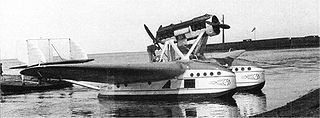
The Savoia-Marchetti S.55 was a double-hulled flying boat produced in Italy, beginning in 1924. Shortly after its introduction, it began setting records for speed, payload, altitude and range.

The Fiat CR.1 was an Italian biplane fighter aircraft of the 1920s. Of wood-and-fabric construction, it was designed by Celestino Rosatelli, from whom it gained the 'CR' designation. Its most distinctive feature was that the lower wings were longer than the upper ones.
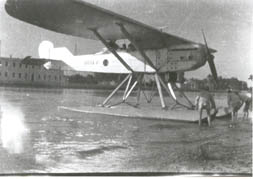
The Breda A.7 was a reconnaissance aircraft developed in Italy for use by the Regia Aeronautica in 1929. It was a braced parasol monoplane of conventional configuration with tailskid undercarriage. The pilot and observer sat in tandem, open cockpits. A single prototype of a long-range example, originally designated A.7 Raid and later A.16 was also constructed, but the air force showed no interest in it.

The Breda A.9 was a biplane trainer produced in Italy in 1928 for the Regia Aeronautica. Conventional in design, it featured a single-bay, unstaggered wing cellule and fixed tailskid undercarriage. The student and instructor sat in tandem, open cockpits. A slightly smaller version, designated A.9-bis was developed for use in Italy's aeroclubs.

The Caproni Ca.165 was an Italian biplane fighter developed just before World War II, but produced only as a prototype, as the competing Fiat CR.42 Falco was selected for series production.

The SAI-Ambrosini SS.4 was an Italian fighter prototype developed in the late 1930s, featuring a canard-style wing layout and a pusher propeller. Development of the SS.4 was abandoned after the prototype crashed on its second flight.

The Savoia-Marchetti SM.78 was an Italian bomber/reconnaissance biplane flying boat of the early 1930s.

The Savoia-Marchetti SM.62 was an Italian single-engine maritime patrol flying boat produced from 1926. It served with the Regia Aeronautica and with a number of foreign users, and was licence-produced in Spain and the Soviet Union. Some of the Spanish aircraft were still in service during the Spanish Civil War
The Piaggio P.32 was an Italian medium bomber of the late 1930s, produced by Piaggio, and designed by Giovanni Pegna. It was a modern design for its time, but was a failure due to lack of powerplants commensurate with its high wing loading.
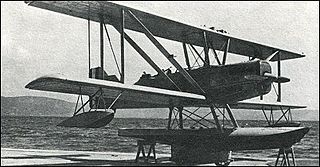
The Piaggio P.6 was an Italian catapult-launched reconnaissance floatplane designed and built by Piaggio for the Regia Marina.
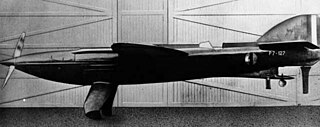
The Piaggio P.7, also known as the Piaggio-Pegna P.c.7, was an Italian racing seaplane designed and built by Piaggio for the 1929 Schneider Trophy race.

The Piaggio P.23R, also known as the Piaggio P.123 for propaganda purposes, was an Italian commercial transport aircraft prototype designed and built by Piaggio.
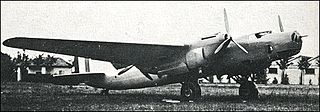
The Piaggio P.50 was an Italian prototype heavy bomber designed and built by Piaggio for the Regia Aeronautica.

The Caproni Ca.90 was a prototype Italian heavy bomber designed and built by Caproni. When it first flew in 1929 it was the largest land-based aircraft in the world.

The Caproni Ca.124 was a 1930s single-engine Italian reconnaissance and bomber seaplane.

The CASA III was a 1920s Spanish two-seat monoplane, designed by Luis Sousa Peco and built by Construcciones Aeronáuticas SA (CASA) at Getafe near Madrid.
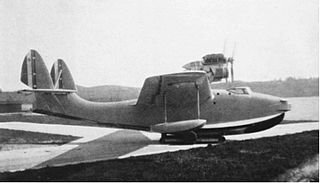
The Macchi M.C.99 was a prototype 1930s Italian twin-engined torpedo-bomber flying boat designed and built by Macchi.

The CANT Z.505 was a prototype trimotor transport floatplane built by CANT in the 1930s.
The Caproni Ca.146 was a high-wing reconnaissance aircraft built by Caproni in the mid-1930s.

The CANT 23 was an Italian trimotor airliner built by CANT in the late 1920s.